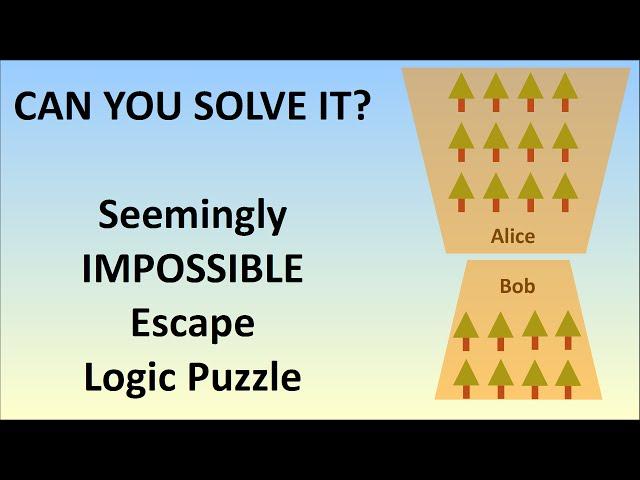
How To Solve The Seemingly Impossible Escape Logic Puzzle
Комментарии:

Give them way more days ruling out 1 tree a day (not 2) and they might get out of jail.
Ответить
It seems to me that Alice should be able to answer on the 2nd morning knowing Bob must see 8 trees.
Considering the rule that both people reason with ABSOLUTE PRECISION.
They each will know the other has worked through the logical processes. In other words they will each make a layout of the logical order of operations for communicating by passing based on the fact there are 18 or 20 trees total. They will each know that the other person has made the same order of operations.
They will also both be able to reason which numbers are already solved in the order of operations. Referenced by looking out of their perspective windows and knowing that there are only 18 or 20 trees.
Alice will know that Bob can see either 6 or 8. Alice will also realize that Bob perceives that it is possible that she thinks he can see 6 8 or 10 trees.
Bob will know that Alice sees 10 or 12 trees. He will also realize that Alice is aware it is possible he thinks she sees 10 12 or 14.
So both Alice and Bob look down the order of operations for communicating and knowing that the first of the possible numbers in the order of operations that Alice reasons Bob may think Alice can see is 14.
Alice therefore passes knowingly communicating to Bob that she does not see 14.
Bob now passes and therefore knowingly communicates that he does not see 6 trees.
So after Bob passes for the first time Alice now knows that Bob does not see 6 so he must see 8.

This question came in my exam (2024!!)
Ответить
The logic here is flawed. If the answer was 18 or 20 then each would immediately know how many trees the other has to have for both answers but there’s no way to narrow down between the two options
Ответить
Alice:
Bob:
Alice:
Bob:
Alice:
Bob:
Alice:
Bob:
Alice: It's 20

Bob and Alice would become best friend after if they actually succeed that way
Ответить
The assumption that they reason with ABSOLUTE PRECISION means that Alice can free them on day 2.
Both people will assume that the other person as well as themselves will reason with ABSOLUTE PRECISION.
They will both know the entire order of operations for communicating by passing. They will both be able to reason this before anyone passes.
They will also know which numbers on the order of operations are already solved by looking out the window and knowing there are 18 or 20 trees.
Alice will know the first possible number that Bob could think she can see is 14. Bob also realizes this.
For this reason Alice will pass on the first day knowingly communicating that she does not see 14.
Bob will know this and pass communicating that he does not see 6.
Alice will know that because Bob does not see 6 he must see 8.
[Note:] I realized because of the legally vague phrasing of certain parts of the rules:
The answer is that yes Alice and Bob can do better than random chance and No they cannot answer with Absolute certainty.
This is due to the fact that we don't know if Alice and or Bob actually want to escape as soon as possible. It only says that they don't want to stay in the evil logician's prison forever.
So both Alice and Bob have no idea if the other person wants to stay in prison as long as possible in which case they would select the slowest possible method for communicating.
If the rules as stated also said: It is known by all that Alice and Bob want to be set free as soon as possible. Then we could say there is certainty that they would be set free. ( On day 2 by Alice)
As it is now , choosing the fastest possible escape seems to be the safest way to prevent being locked in prison forever. Although not a certainty.

Your answer takes far too long.
Right from the start, if the choice is 18 or 20 and Alice can see 12 trees she knows that Bob can see either 6 or 8 trees .. and Bob, who can see 8, knows that Alice can see either 10 or 12.

That is simply just not how I would think in that situation 😂
Ответить
So, after some serious thinking, it's definitely possible to get out on day 3 instead of day 5. I had thought day 2 was possible, but in Alice's perspective, Bob might think that she thinks he could have as low a 4. So when she passes on day one, the two of them lock in that knowledge that Bob has at least 4. You then follow the process of elimination from there. The first two days are totally unnecessary since they establish was can already be established from the get go, the lowest or highest number that the other person could possibly think you might have. In this case it's 14 and 4.
Ответить
The following is entirely Alice's thoughts.
Alice knows Bob sees 6 or 8 trees. She assumes Bob sees 6 trees and is having similar thoughts towards Alice. Bob with a potential 6 trees thinks: "Alice either has 12 or 14 trees. If she has 14, she'll think I have either 6 or 4. With 4 trees, I'd think Alice has 14 or 16 trees. Alice with 16 would think I either had 2 or 4. Me with 2 would assume she has 16 or 18. Alice with 18 would think I had either 0 or 2. If I had 0, Alice has 18 or 20. Alice with 20 would know the answer, and the evil logician would set us free before my turn.

Not an answer yet but since the answer are either 18 or 20, from alice(A) perspective bob(B) trees are either 6 or 8. While from B perspective A trees are either 10 or 12..
My answer:
So from A perspective, the possibilities of B trees and the possibilities of how B would think of A's and on should be like :
A(12) then B(6) or (8)
If B(6) then A(12) or (14)
If A(14) then B(4) or (6)
If B(4) then A(14) or (16)
If A(16) then B(2) or (4)
If B(2) then A(16) or (18)
If A(18) then B(0) or (2)
If B(0) then A(18) or (20)
1st day if A 20 then A would have answer 20. But she pass. If B 0 knowing that A isnt 20 but 18 then B would have answer 18. But he pass.
2nd day if A 18 knowing that B isnt 0 but 2, then 20 it is. But she pass. If B 2 knowing that A isnt 18 but 16, then 18 it is. But he pass.
3rd day if A 16 knowing that B isnt 2 but 4, then 20 it is. But she pass. If B 4 knowing that A isnt 16 but 14, then 18 it is. But he pass.
4th day if A 14 knowing that B isnt 4 but 6, then 20 it is. But she pass. If B 6 knowing that A isnt 14 but 12, then 18 it is. But he pass. At this point A would have known that B isnt 6 but 8. Since from A's perspective B is either 6 or 8. And since her own trees are 12 adding with 8 of B's will give 20 as an answer for the 5th day..
Oh i missed by 1 day.. both knew that they each have trees on their side so no one have 0 trees.. and both knew that each have an even number of trees so i should have start from A(18) and B(2) instead.. so it only took 4 days for A to get the right answer xd

Seems lot of people get confused bout the logic in this vid(me too at 1st).. but then i realized, there are 2 kind of logic in this case.. 1st logic based on individual perspective, 2nd logic based on collective perspective..
Logic based on individual perspective only works for each participant and doesnt work for the other and cant be mixed..
Alice having 12 so bob is either 6 or 8 are alice's individual perspective logic, doesnt work on bob. Bob having 8 so alice is either 10 or 12 are bob's individual perspective logic, doesnt work on alice. So if both alice and bob insist on using each of their own individual logic then for alice, bob will always be either 6 or 8 and for bob, alice will always be either 10 or 12 regardless of how many days have passed with each of them choose to pass. Therefor the puzzle cant be solved.
While logic based on collective perspective are the kind of logic in which every participant knew for sure altogether at the same time. So this kind of logic works for every participant without any single one able to deny it. For alice, bob is either 6 or 8 but not sure which. For bob he IS 8 but alice didnt know bout it, vice versa.
In order for this problem to be solved, they also need to use logic based on collective perspective, then add or compare it with their own individual perspective.
In the beginning, alice having 12 so bob could be 6 or 8 and bob having 8 so alice should be 10 or 12, these are logics based on individual perspective of each person. Then in the beginning, what is their collective perspective logic regarding the number of each others trees? The kind of information bout trees number that both of them knew altogether aside from the answer be a total of 18 or 20? Nothing, beside of the total of 18 or 20 there are no other information bout any other numbers that be known to both person altogether at the same time at the beginning, bob didnt know for sure bout alice's 12 and alice didnt know for sure bout bob's 8. Means, from collective perspective logic what alice know bout bob's number isnt 6 or 8, but "?", what bob know bout alice's number is also not 10 or 12, but "?". So at the beginning, the logic based from collective perspective of both person, each could have any numbers from zero to 20, while the opposition should have any numbers from 20 to zero.
Then what they need to do next is using the "pass" that each person gave as an answer each day to eliminate numbers that doesnt fit the collective perspective logic, then comparing the remaining possible numbers with the possible numbers based on any of each individual perspective. When both have eliminate enough numbers they will eventually found the only possible number that fits both the collective perspective logic or any of their own individual logic, that makes any of them to be able to conclude whether the answer is 18 or 20. So the vid above is correct xd

Check my logic! 3 Day solution possible?
For me this puzzle has went from interesting to a rollercoaster , to a kaleidoscope of possibilities! I thought there was a 2 day solution until comment discussion led me to recheck at which point I realized what I believe to be a different method for looking at and explaining the problem and solution which may be a 3 day escape.
First: In order to presume that the fastest escape possible would be the logical choice we would have to assume that both Alice and Bob are aware that they want to escape as soon as possible. ( The video does not clearly state this , although it is implied by the statements that the "Evil Logician" and the fact they " don't want to be in prison forever". For the sake of this argument I am going to assume that Alice and Bob know that they both want to escape as soon as possible.
Second: Alice and Bob are said to be able to reason with ABSOLUTE Precision. Due to this implication it will be assumed that they will be able to solve any possible logical problem by calculating any and all possible combinations of actions , as well as calculating any all the possible combinations from their partners perspective while at the same time recognizing and bypassing infinite loops of calculations. They will then use logic to mutually select the fastest assured escape combination possible. ( Lets just say for the sake of argument that Alice and Bob are advanced quantum computing capable Artificial Intelligence.)
Third: Any observed and already mutually known information will take priority when making final decisions over any assumed theory.
[Edit:] The ensuing conversion resulted in the realization that the following "4th" needs to be clarified.
Fourth: It is acknowledged that Alice and Bob have common knowledge of a certain creative function. This is not stated in the video but is implied by the fact that ; in order to work out and create the communication system the solution requires for them to remove , deprioritize or forget certain obvious knowledge such as how many trees they can see and if they know how many trees the other sees + or - 2 . This is recognized as a random simulator ability in Alice and Bob that allows them to simulate and test various possibilities. They then test these various possibilities to find the ones that lead to the fastest guaranteed escape. We see this in the fact that AFTER Alice and Bob create the communication system they intermittently "remember", "reprioritize or "add" back in the knowledge of how many trees they can personally see. This allows them to solve with the solution as described.
The following solution makes the statement that : Since we know they can test different possibilities and therefore ; seemingly arbitrarily "remember", "reprioritize or "add" the knowledge of how many trees they can see ; then they would also "remember", "reprioritize or "add" back in the common knowledge that they both know many each other can see +or-2. This will result in them finding common knowledge of the faster guaranteed escape beginning on day 3.
We know that for the order of operations for communication to be established as common knowledge : there must be a repeating loop of assumptions made of ever increasing uncertainty until they reach a stopping point at absolute uncertainty. (In order for them to do this they must remove the common knowledge of them knowing how many trees they can each personally see as well as how many trees each other can see + or -2) When absolute uncertainty is reached they can then "remember" how many trees they can see and by testing different possibilities create communication systems. By applying the common knowledge that there are only 18 or 20 trees they can reach a common knowledge of the "fastest" communication table that uses only even numbers:
Alice's passes | Bobs Passes
Day(1) >20 < 0 and >20
Day(2) < 0 and >18 < 2 and >18
Day(3) < 2 and >16 < 4 and >16
Day(4) < 4 and >14 < 6 and >14
Day(5) < 6 and >12 < 8 and >12
Day(6) < 8 and >10 < 10 and >10
Alice and Bob know that if they simulate to the Common Knowledge point of absolute uncertainty they will arrive at the following possibilities for escape depending on how many trees each can see.
[Escape] [Alice] [Bob]
[Days] [has] [has]
| | |
Day 1 20 ---- 0
Day 1 18 ---- 0
Day 2 18 ---- 2
Day 2 16 ---- 2
Day 3 16 ---- 4
Day 3 14 ---- 4
Day 4 14 ---- 6
Day 4 12 ---- 6
Day 5 12 ---- 8
Day 5 10 ---- 8
Day 6 10 ---- 10
Day 6 8 ---- 10
Day 5 8 ---- 12
Day 5 6 ---- 12
Day 4 6 ---- 14
Day 4 4 ---- 14
Day 3 4 ---- 16
Day 3 2 ---- 16
Day 2 2 ---- 18
Day 2 0 ---- 18
Day 1 0 ---- 20
When they simulate removing various "days" from the communication system they will find that there is an area that guarantees them escape based upon the common knowledge : {Each knows that the other is aware of how many trees they can see + or - 2.} When they both apply this common knowledge as priority then it will lead to a faster guaranteed escape. Since this common knowledge leads to the fastest escape it will be prioritized over starting from the common knowledge of absolute uncertainty.
Alice's passes | Bobs Passes
Day(1) >20 < 0 and >20
Day(2) < 0 and >18 < 2 and >18
_____Start below this line_____
Day(3) < 2 and >16 < 4 and >16
Day(4) < 4 and >14 < 6 and >14
Day(5) < 6 and >12 < 8 and >12
Day(6) < 8 and >10 < 10 and >10
Alice and Bob will simulate the various possibilities and realize that no matter what numbers they can individually see : if they base their starting communication actions on the common knowledge layer of knowing each other can see + or - 2 and start on "day 3"; then it will result in the following table.
[Escape] [Alice] [Bob]
[Days] [has] [has]
| | |
Trapped 16 ---- 4
Day 1 14 ---- 4
Day 2 14 ---- 6
Day 2 12 ---- 6
Day 3 12 ---- 8
Day 3 10 ---- 8
Day 4 10 ---- 10
Day 4 8 ---- 10
Day 3 8 ---- 12
Day 3 6 ---- 12
Day 2 6 ---- 14
Day 2 4 ---- 14
Trapped 4 ---- 16
Below are some of the important possibilities that we see happen when Alice and Bob simulate and they reapply the common knowledge that they know how many each other can see +or-2 to the Sim Bob and Sim Alice logic:.
Alice or Sim Alice : Knows that she can see 12 trees.
Therefore Bob Can see 8 or 6 trees.
If Bob sees 6 trees he will know she can see maximum 14 trees.
Starting on day 3 works 100%
Sim Alice : Knows that she can see 14 trees.
Therefore Bob can see 6 [ Invalid after this point ] or 4 trees.
If Bob sees 4 trees then he will know that she can see a maximum of 16 trees.
Thus starting Starting from Day 3 works 100%
Bob or Sim Bob : Knows that he can see 8 trees.
Therefore Alice can see 10 or 12 trees.
If Alice sees 12 trees she will know he can see a minimum of 6 trees.
Starting on day 3 works 100%
Sim Bob : Knows that he can see 6 trees.
Therefore Alice can see 12 or 14 trees.
If Alice sees 14 trees [ Invalid after this point ] then she will know that he can see a minimum of 4 trees.
Starting from Day 3 works 100%
This solution depends upon them testing the possibility of prioritizing + or - 2 knowledge on top of the communication system. This makes the solution an algorithm rather than a set standard and it will change depending on the numbers that Alice and Bob actually have. ( It will not have the same choices if Alice saw 16 and Bob 4 )
I have included the following for anyone that wants to have a short "key" abbreviated description.
Below are the Common Knowledges and Logic choice paths that Alice and Bob have in this solution.
(A) They are both perfect Logicians
(B) They know there are 18 or 20 trees in total
(C) Loop 1 knowledge: They both know they both have common knowledge about how many trees they can personally see and when combined with B they know that their first layer of knowledge about how many trees the other sees is + or -2.
(D) They know that they will simulate possible choices and then use the results to select the choice paths that lead to guaranteed freedom,
(E) They know that if they follow the logical simulation of how many trees each other can possibly see, they eventually wind up and total uncertainty which is a stopping point.
(F) They know that they will simulate possible choices and then use the results to select the choice paths that lead to guaranteed freedom as fast as possible .
(G) If both Alice and Bob start on Day 3 of the communication table they will have the fastest guaranteed escape
With the above common knowledge we can see that at some point of experimentation Alice and Bob will have to try "ignoring" or removing various common knowledge understandings in order to test different possibilities.
They process with (D) which will eventually lead them to ignore (C) while applying (D),(A) and (B) which results in (E)
After they have results for (E) ; then reapplying (C) and processing (D) again , then testing with (F) which results in common knowledge (G)
(G) = If both Alice and Bob start on Day 3 of the communication table they will have the fastest guaranteed escape.

this look nice, but that doesn't work, sure bob could deduce that alice have less than 19 after she pass, but Bob already know Alice have either 10 or 12, so this deduction doesn't make sense
Ответить
Day 1:
Alice knows she sees 12 trees, which means Bob can see 6 or 8.
Bob knows he sees 8 trees, which means Alice can see 10 or 12.
Alice knows that the full range of values Bob could deduce about her is (10, 12, 14).
Bob knows that the full range of values Alice could deduce about him is (6, 8, 10).
14 is the max possible number of trees for Alice to be able to see based on their common knowledge.
Therefore, 14 is the logical starting point for deciding how to answer on day 1.
If Alice saw 14 trees, she would answer that there are 20 trees (her 14 plus Bob's minimum of 6).
Since she doesn't see 14 trees, it means that 18 and 20 are both still possible, so she does not answer.
Bob now knows that Alice sees 10 or 12 trees, which means the total can still be 18 or 20 (including his 8), so he also does not answer.
Day 2:
Alice has learned that Bob does not see 6 trees, since if he did, he would have been able to answer that there were 18 trees, and they would have been released on day 1.
Knowing that she sees 12 trees, Alice can now deduce that Bob sees 8 trees, so she correctly answers that there are 20 trees, and they are both released.

This is solvable by Bob on day 2. Immediately, they BOTH know that Alice can believe Bob to have 6, 8, or 10, and that Bob can believe Alice to have 10,12 or 14. When they both pass on day 1, they can both eliminate the possibility that Bob has 10, as there's only one number in Alice's 10, 12, 14 subset that adds to 18 or 20. Now Bob knows she knows he either has 6 or 8, and he knows her to have either 10 or 12. On day 2, if she had 10 trees she'd know the answer to be 18 (as she knows he only has 6 or 8. When she passes on day 2, Bob knows she couldn't have seen 10 trees and thereby knows her to have 12.
Ответить
If Alice passes and Bob gets asked the question, shouldn't the only choices be that Alice can only see 10 or 12 trees? If that's the case, Bob would know she can see 12 because if she could see 10, she would've guessed 18 since they can't see the same number of trees.
Ответить
I'm really not satisfied with the solution
Ответить
The other solution is to just take the 50/50
Ответить
why cant bob and alice logically deduce if there must be 18 or 20 trees, and they see 12/8 trees themselves, the other can only see 6 or 8 trees/10 or 12 trees and we can work off of that. i will admit i myself couldnt find a way to jump from the into one definitive answer is neither bob nor alices eyes with that thinking, but if this strategy works there must be a way this or soemthing similar can work as well.
Ответить
Idk why couldn't they just tell each other how many trees they each saw since both would never see the same trees.
I mean if they're close enough to hear the other person they must be close enough to communicate

Either, ever, forever??? There is something wrong with the question so logically the creator of the puzzle is a fraud!
Ответить
I don't know about you guys but I solved it with this simple Logic and it's all in the details.
Alice and Bob are imprisoned in different cells in a prison.
They can't see each other and there is no way to communicate.
Outside the prison there are trees.
Every day, they are each asked the same question by the Garden; "How many trees are there in Total, 18 or 20?"
If answered correctly they are both freed but if not, then they will be imprisoned forever.
The only Two HINTS/CLUES they have is that;
1. Individually they don't see all the trees through their cell windows but Together combined they see all.
2. The total number of trees is either 18 or 20.
How can they figure out the total number of trees using logic?
Now, here is the simple logic behind the answer:
Alice can see 12 trees from her cell window and Bob can see 8 trees from his cell window.
Neither of them knows how many trees they see individually, but the total number Together combined is either 18 or 20.
As we are shown in the Video, all the trees are located/planted in rows and each row contains 4 trees.
If the answer is 18 trees;
In Alice perspective, as she sees 12 (3 rows having 4 trees each) out of 18 trees, that means that Bob sees 6 trees with one row containing 4 trees and the second row containing only two.
And vice versa, if Bob sees 8 (2 rows having 4 trees each) out of 18 trees, that means that Alice sees 10 trees with two rows containing 4 trees each and one row containing only two.
But in the second scenario, if the answer is 20 trees, then in both Alice's and Bob's perspectives, each one is seeing the same number of trees in each row, which is 4.
So, the more logical answer here is 20 trees.

YES they will set free immediately
Assume each can see at least 1 tree
Question says 18 or 20 trees?
Assume that same question was repeated each time
Solution:
Alice could logically argue that if she sees at least 18 trees,
which is the minimum number of trees as the question also asks her to choose,
then she can rely on next answer 20 and exclude 18 (condition that each can see at least 1 tree)
Let's Assume she passes the question to Bob instead of giving an answer
Bob argue that:
If Alice did not answer, then the (true) no of trees that she might have seen is even lesser than the least number which is 18 (if not she may not pass it to me)
Bob can see 8 trees for sure therefore Bob can give an answer which is
20-8=12
So in together Alice + Bob sees which is (12+8 =20 trees)
They will set free immediately .

Solved this awesome problem!
Ответить
I asked this question to GPT-4 Turbo and GPT-4o, and both gave me idiotic answers.😔
Ответить
They cannot communicate with each other but if Bob is asked the question, then he knows that Alice had passed. Then, if Bob also passed, the game is over because they would both have passed and there would be no one alive to be asked the next day. What a sad story.
Ответить
After Day 1, Alice knows for a fact that Bob either have 6 or 8 trees
Similarly, Bob knows that alice either have 10 or 12 trees
After Day 2, Alice have no clue, which lead Bob to find the correct answer (20)

Nah bro I like my chances
Ответить
Day 1:
Alice gets the question, so she knows Bob sees 6 or 8, or otherwise said her information on Bob is (6,8) but Bob doesn't know that.
Bob gets the question and his information on her is (10,12) but Alice doesn't know that.
He also knows she knows he sees 6, 8 or 10 but she couldn't decide. Bob knows her information hasn't grown, and it must be a subset of (6,8,10).
Day 2: Alice's turn again
She knows his information is (12,14) if he has 6 and (10,12) if he has 8.
Similar to Bob's turn on day 1, she can infer his information on her is a subset of (10,12,14) since it hasn't grown.
This doesn't increase her information on Bob: it remains (6,8)
She also knows that her indecisiveness hasn't given him new information.
If he has 6 then his info goes from (12,14) to (12,14,16). If he has 8 then it goes from (10,12) to (8, 10,12).
Now suppose Alice would still think he can have 10 (which she doesn't, but he doesn't know that yet), which means his info on her be (8,10). But since it is also a subset of (10,12,14) since it hasn't grown on day 1, his info on her would be 10, in which case he has (8,10), in which case she knows the total must be 20 (and he has 8 which is a contradiction).
Since she doesn't make any call, it is clear to Bob she can't think he has 10. Which means her information is (6,8), which means she has 12.
This allows Bob to call 20 on day 2.

" IF BOB SAW 0 OR 1TREE THEN KNOWING THAT ALICE HAS AT MOST 18 TREES THEN BOB COULD CONCLUDE THAT THERE ARE 18 TREES "
hold on, if alice had 18 trees exactly and bob had 1 tree then the total would be 19 and bob would NOT be able to conclude whether there were 18 or 20
am i correct ?

The word "pass" confused me. It took a while for me to realize it mean "not answer" and not guess correctly
Ответить
So if she passes and Bob passes, do they repeat it again or set free?
Ответить
Ask the evil logician to have them swap cells. Then both will be able to see what the other saw and deduce there are 20 trees.
Ответить
Im picturing Alice doing these complex calculations in her head, and Bob is just passing to stall time haha
Ответить
Here is my solution of 1 day: Alice, when asked, knows there are 4 possible pairings (10 and 6, 10 and 8, 12 and 6, 12 and 8.)
and she can eliminate pairing 10 and 6 because 10+6 = 16 and because she sees 12 trees. the latter also implies in the elimination of the pairing 10 and 8. Alice cant know if Bob sees 8 or 6 trees, so she passes. After this, Bob also eliminates 10+6 and is left with 3 possibilities (1 where the sum is 20 and 2 where it's 18.) the pairings with the sums 18 are 10 and 8 and
12 and 6. since Bob knows that alice eliminated 10 and 6, he can conclude that she won't eliminate the pairing 12 and 6 since that would leave her with 2 possibilities that contradict the amount of trees alice sees (12 and 8 and 10 and 8) she can't see 12 and 10 trees at once and she doesn't know if Bob sees 8 or 6 trees so she cant leave the possibilities that both have 8 therefore alice has 12 trees because she must eliminate all the possibilities with ten in them in order to not contradict herself. so Bob know that Alice sees 12 trees and can say 20 from day one.

nice puzzle, had to give it a good think before i solved it, but not with the most optimal solution
Ответить
Are there 18 or 20 trees in total? Yes.
Ответить
Do Alice or Bob know if they have green eyes?
Ответить
I think the riddle has no logic at all. How do they know that they see different trees? If Alice sees two trees that also Bob can see then it’s 18 trees. Even if they, by some magic, could calculate how many trees the other one see.
Ответить
Uhhhh... what?
Ответить
Not only badly explained but pretty sure the solution is wrong. Bob has 8 trees so he already knows from day 1 that Alice has at most 10 or 12 trees, not that she has 18 or less lol
Ответить
Well to answer the question, no they cannot pass with certainty. There is no way for either of them to be absolutely certain they're both on the same page.
Ответить
They are trapped by a logician. That doesnt mean that Alice or Bob are logicians.
Ответить
I thought they knew, that every tree is seen only by one person , meaning they would know the other Person could only have 6 or 8 ,or 10 or 12 , depending on the real total. That could have been communicated better😏
Ответить

























